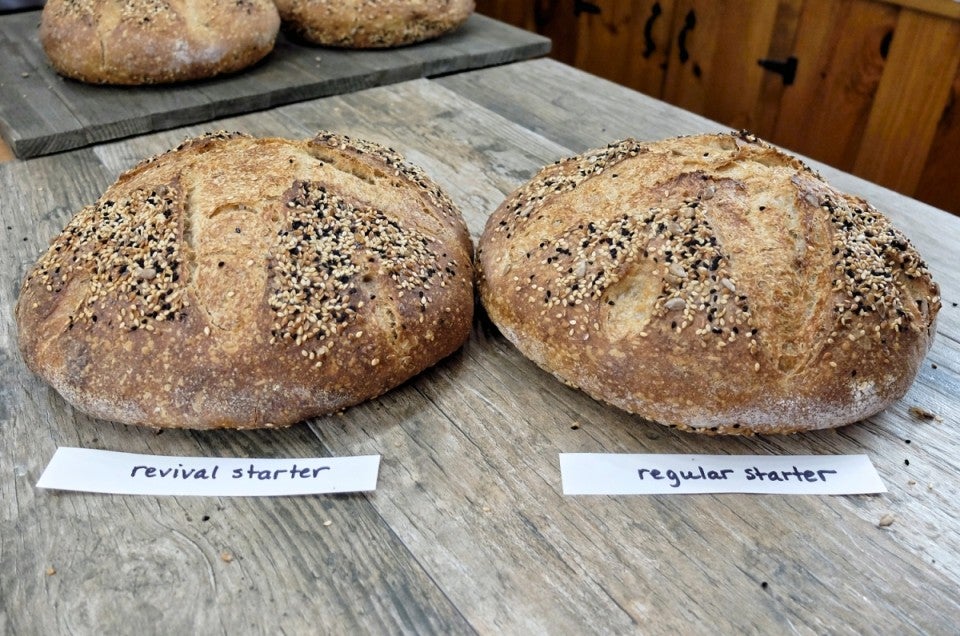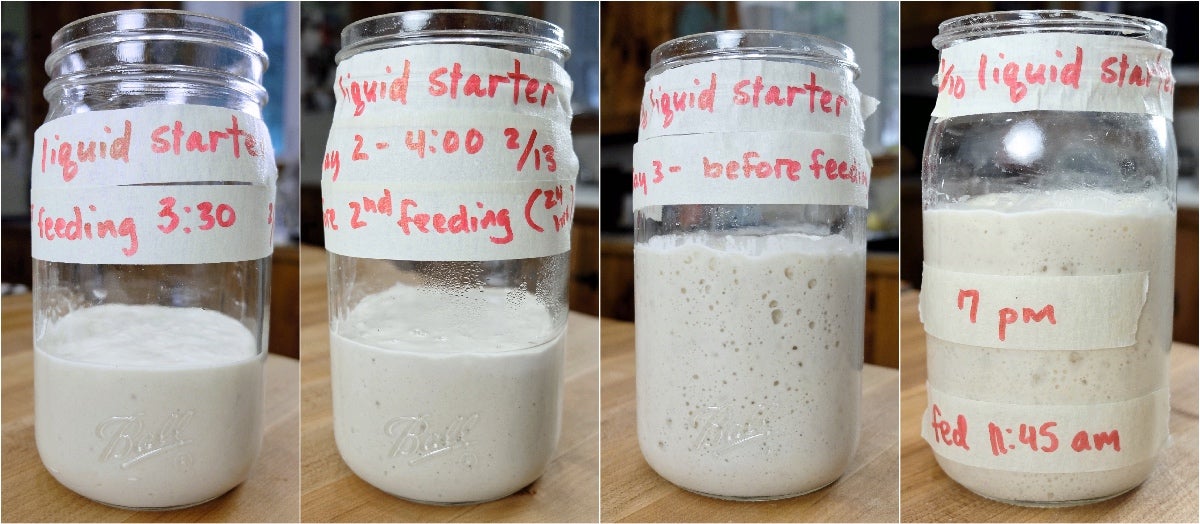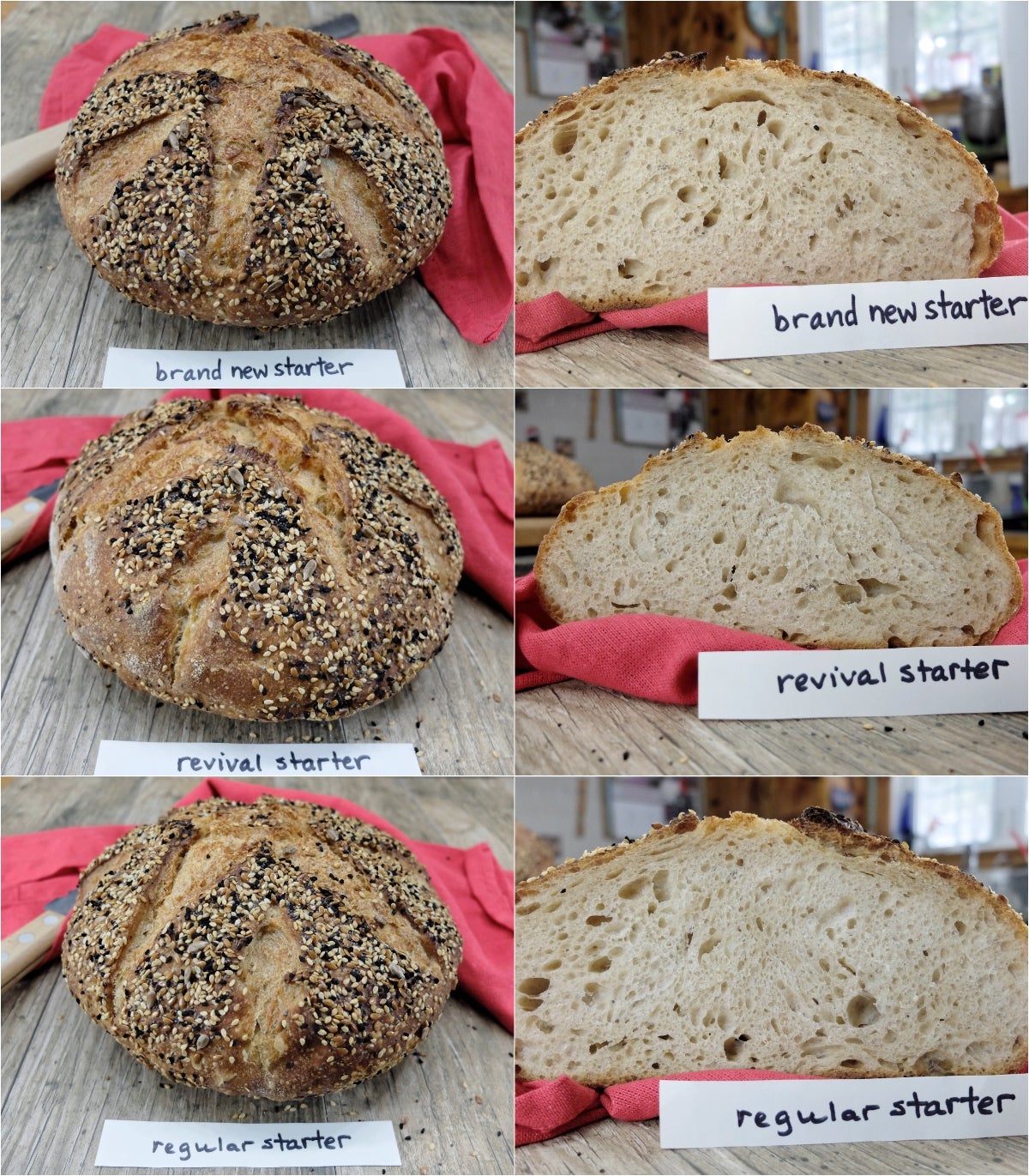


In our first sourdough starter troubleshooting post we tackled sourdough starter viability, and what will and won't cause your starter's demise. We also found out what a spoiled starter looks like, and how to know when it's time to throw it out and start over.
Today we'll take on the thorny question of whether it's worthwhile to try to revive an old but struggling starter — or if it's best to start over.
Creating your own starter from scratch is exciting and even a little magical; for details, see our step-by-step guide to creating a sourdough starter.
Simply mixing flour and water allows friendly bacteria and wild yeast to join forces and establish a balanced ecosystem that is able to impart great flavor and rise to your sourdough baking.

During the 6 to 10 days that it takes to get your starter up and running, it's a little more vulnerable to bacterial intruders and mold because it hasn't yet developed the defenses of a mature starter. But once fully developed, a well-maintained starter will readily fend off unwanted invaders and is very unlikely to spoil.
What if you inherited an old starter from your grandma and it's looking a little like it might be at death's door?

Sourdough authorities argue that there's nothing sacred about an old starter; a freshly developed "mature" starter will impart just as much flavor and rise to your bread.
Starting over with a new starter will get you back to baking great sourdough bread in a little over a week. So why take on the unpredictable task of trying to resurrect a sickly starter?
And is it even possible to thoroughly revive a starter that's sorely neglected?
Let's find out.


I start with two very neglected starters. Both starters (one all-purpose, one whole wheat) had been well-maintained until they were left at room temperature for a full month without being fed.
Why test both a white and a whole wheat starter? Starters can be maintained with all different types of flour, so I wanted to see if a whole wheat starter responded in the same way as a starter fed with all-purpose flour.


I pour the dark hooch off the neglected starters, and feed them following the feeding schedule called for in our sourdough starter recipe.
The revived starters smell a little "off" at first, but not awful; think vinegary sour, with a slightly unpleasant edge. Within four days they're rising well and have a nice, mildly tangy aroma. My theory is that both the acidity and the maturity of the neglected starters helps them fight off unwanted bacteria at the beginning of the process, which might allow for a faster return to a healthy and balanced starter.

By way of comparison, I also begin a starter from scratch. My brand-new starter is able to keep up in terms of rise. However, after four days it still smells a little funky and doesn't seem quite ready for baking bread.
On Day 4 (after only four feedings) I bake Naturally Leavened Sourdough Bread using my revived starters (which I mix together for the test), and my regularly well-maintained starters.


The results are a little shocking: two beautiful and delicious loaves. Both loaves taste mildly sour, although taste testers agree that the revived-starter loaf is slightly tangier.
On Day 5, after a total of six feedings, I try another test bake—this time including the brand-new starter; the revived starters, and my well-maintained regular starter.

Again, the results are surprising: three nice loaves, each with a similar rise and crumb structure. The only real difference is in the flavor of the breads. Each has mildly sour flavor, but the brand-new starter yields a slightly blander loaf.
It's definitely worth trying to revive a neglected starter (so long as it shows no signs of contamination). Pour off any discolored hooch, and start feeding it twice a day at room temperature. If it rises well and has a good aroma after three to four days, you're back in business!
We'd love to hear your own sourdough starter stories and questions below. Did you revive your starter from the brink of death? How long did it take? Is it thriving now?
For more information, please check out our first sourdough starter troubleshooting post.


April 12, 2020 at 7:16pm
Hi Barb, I am on day 13 of a 50/50 rye and unbleached all-purpose starter. For the past week, I have been on a 1:2:2 ratio feeding of starter:water:flour on a once every 24hr schedule. For the first week I was closer to a 1:1:1 ratio. It is quite cool in the house, around 65F, so I have been keeping it in a small enclosed space next to another jar of hot water to keep the temp up. It went through the aforementioned bacteria growth around day four and then quieted down. It now smells much better and bubbles, rising only 2-4 cm in a tall mason jar, but never doubles in size. Is there an issue with yeast activity, temp, or ratios, or am I just not being patient enough?
April 18, 2020 at 7:53am
In reply to Hi Barb, I am on day 13 of a… by Sara (not verified)
Hi Sara, I'd try to keep your starter in the 70-80ºF range and see it this improves its activity level. If you have an instant read thermometer you can check its temperature now and then. If your starter is cooling off at night or during the day and falling into the mid-60's, that could definitely be slowing down fermentation. Some people find the oven with the light provides a nice, warm environment. Otherwise it sounds like you're doing everything right and your starter is definitely moving in the right direction. Hopefully with a little more warmth it will start doubling and you can switch back to the 1:1:1 ratio and twice a day feedings with AP flour. Once your starter is rising well with that feeding routine, then you should be good to go! Good luck, and let us know how it goes!
Barb
April 12, 2020 at 12:30pm
I’ve been working on my starter for just over 1 week, feeding daily. I may not have discarded enough starter initially but have better recently. I have started to notice some separation, spongy layer on top, a thin amount of liquid in middle, and paste like bottom. Is this separation normal?
April 17, 2020 at 8:32am
In reply to I’ve been working on my… by Nate (not verified)
Hi Nate, if you're following our sourdough starter recipe than the normal consistency of the starter is a thick, but stirrable paste right after feeding. As the starter rises and ferments it becomes more like at thick pancake batter when it's at its peak of rising. Once it reaches its peak, if it isn't fed again, it will gradually fall back to the level that it was when it was first fed, but the consistency will be quite different--thinner, with perhaps a foamy layer of bubbles on the top. Often a starter that hasn't been fed in a while will also develop liquid on top, which is called hooch. So, while it's not uncommon to see layers of different textures in your starter, you might be seeing something a little different. If you happen to be feeding equal parts by volume rather than weight, this can result in a very liquidy starter that is more likely to seperate in the way you describe, so I would encourage you to measure your ingredients carefully and to shoot for equal parts by weight. If you don't have a scale, that would be 1/2 cup (4 ounces, 113g) starter + 1/2 cup (4 ounces, 113g) water + 1 scant cup (4 ounces, 113g) AP flour. I hope this helps! Let us know how it goes.
Barb
April 12, 2020 at 8:21am
I used unbleached white flour for my sourdough starter and have been feeding it with unbleached white flour. Now on day 14, light brown specks have appeared throughout.
Is it ruined?
April 17, 2020 at 7:51am
In reply to I used unbleached white… by Cora (not verified)
Hi Cora, did you happen to stir in some darker colored liquid (hooch) from the top of your starter? If so, this might account for the specks you're seeing, and would be totally harmless. I'm assuming you've been feeding your starter regularly and it has been responding well, but if this isn't the case and you thing your starter might be developing mold or a pink or orange streak/tinge then you might want to start over. However, what you've described doesn't sound too worrisome. I would probably continue and see if your starter returns to it's normal look/aroma after a few more feedings at room temperature. Good luck, and let us know how it goes!
Barb
April 11, 2020 at 3:40pm
Hi! I’m on day 6 of my sourdough starter using the recipe online here and I haven’t experienced any rising yet. I’ve been feeding twice a day in a 1:1:1 ratio. Should I change something?
April 16, 2020 at 12:35pm
In reply to Hi! I’m on day 6 of my… by Camron Kaiser (not verified)
Hi Camron, I apologize for the delay in responding to your question! As you may have gathered from reading through the comments, you have two choices at this point. You can either continue on as you are doing and eventually the starter should begin to rise predictably. You could also try the alternative feeding routine suggested to us by microbiologist, Debra Wink, which increases the acidity of the starter and seems to pave the way for more yeast activity. This method is as follows:
1. Feed only once per day.
2. Feed with whole wheat or whole rye flour, if available. If you only have AP, that's okay.
3. Feed by weight with a ratio of 2 parts starter : 1 part water : 1 part flour. For example, you could save 1/2 cup (4 ounces, 113g) starter and feed 1/4 cup (2 ounces, 57g) water and 1/2 cup (2 ounces, 57g) whole grain flour.
Once the starter is rising predictably, switch back to our regular starter recipe. You should expect a certain amount of delay each time you switch your starter's feeding routine, as the organisms need time to adjust, but once the starter is rising predictably with the twice a day feedings, 1:1:1 ratio, and AP flour, then you should be good to go!
I hope this helps! Let us know how it goes,
Barb
April 11, 2020 at 2:44pm
Hi there! I've found this while looking for ways to tell if my 10-day old starter is ready for baking.
Its been consistently rising for the last 3 days with lots of bubbles and froth on top but I don't ever see it fully double in size-its always just a bit under. And it doesn't pass the float test :( I feed and discard every morning and do a feeding 12 hours later before bed, and smells a bit like vinegar. Would you say it's ready for baking?
April 16, 2020 at 11:38am
In reply to Hi there! I've found this… by Emily (not verified)
Hi Emily, I apologize for the delay in responding to your question! It sounds like your starter is doing very well, and you could certainly use it for baking at this point. However, I'm curious about the consistency of your starter. What you're describing sounds like a starter that may be a little too liquidy. We recommend feeding your starter equal parts by weight of starter, flour and water. If you don't have a scale, that's 1/2 cup (4 ounces, 113g) starter + 1/2 cup (4 ounces, 113g) water + 1 scant cup (4 ounces, 113g) AP flour. If you were feeding equal parts by volume of starter, flour and water this would result in a much more liquidy consistency, which would have a harder time doubling in size because the fermentation bubbles would tend to rise through the starter and collect on the surface, rather than being dispersed throughout. Another possible cause might be if you're using very warm water to feed your starter. This could cause fermentation to occur more rapidly than expected, so that your starter has collapsed significantly by the time you go to feed it 12 hours later. Try feeding with room temperature water (70ºF), and storing your starter in a spot that is also in the 70's. Look for a starter consistency that is a thick, but easily stirrable paste right after feeding. As it rises and ferments it should become more like a thick pancake batter when it's at its peak (check for this 6-8 hours after feeding). If the starter isn't replenished at its peak it will gradually collapse down to the level it was when you first fed it, with the kind of frothy bubbles you describe collecting on the top. I hope this helps! Let us know how it goes.
Barb
Pagination